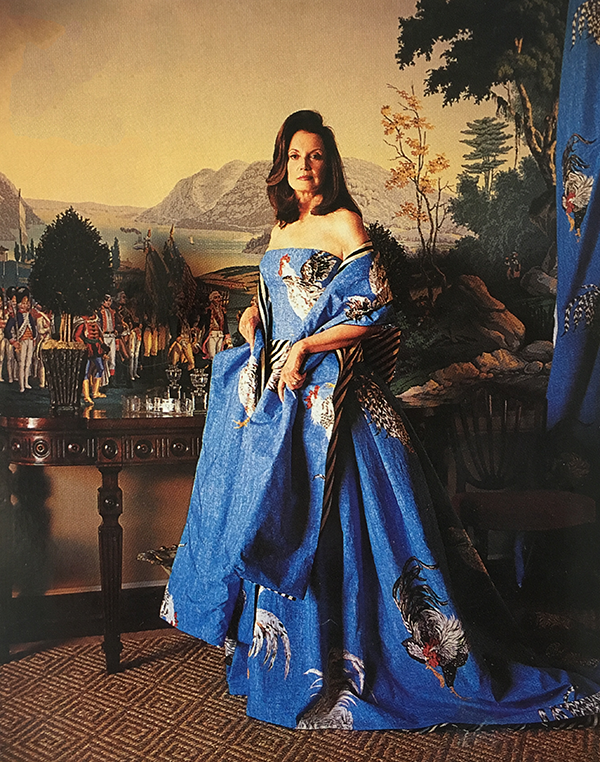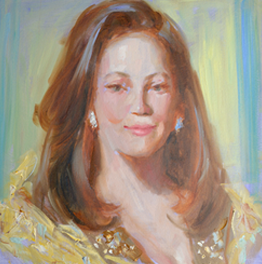
Is there one single image that captures the spirit of the Paris Couture Week that was? Naomi Cambell sauntering into the Versace show holding the hand of Kevin Spacey? Wait. No. It was earlier that Saturday, at John Galliano’s, kaleidoscopic masterpiece of a show for Dior-that subtle yet sophisticated use of toile de Jouy.
What’s toile de Jouy? It’s the fabric invented in eighteenth-century France, used mostly for interior decoration and furniture upholstery. Galliano appropriated it for a pair of wide, wide trousers-an inky-red print on beige twill-worn with a gray hooded sari-like shirt embroidered with crystals, and a quilled patchwork bomber. It was an instant home run: Toile de Jouy is the new couture fabric.
INTERIOR MOTIVES
Galliano wasn’t the only designer thinking about upholstery. Early Monday evening, Oscar de la Renta, at Pierre Balmain, had taken his love of rich interiors and created something very elegant.
“You just can’t find beautiful prints anymore,” de la Renta said. “So I decided to go to the textile sources used by interior decorators. I love the scale of the prints.”
He reminded me that this wasn’t the first time he’d used bombastic upholstery silks as rich stuff for his Balmain customers. One of his favorite “French furniture” looks, a striped tea gown from the 1998 collection (made of Veraseta drapery cloth), can be found in the closet of his wife, Annette, as well as in the closet of his favorite client, Jayne Wrightsman. Both ladies showed up at a weekend party that summer at Chatsworth, the home of the duke and duchess of Devonshire, dressed in the ruffled, romantic tea-gowns-with-train.
This year, de la Renta’s Balmain oak-leaf-and-acorn print, from Le Lièvre, was ruffled from throat to floor. Bree Mortimer, in Paris for summer studies and a fashion internship, slipped into the green-on-cream look for your StyleFaxer. “I did my high school senior thesis on Versailles,” said Mortimer, who, like her famous grandmother Babe Paley, lives for fashion. “I could see Marie Antoinette walking in those rooms in the palace, and I could see myself in her beautiful dresses!”
Did you know that the queen spent every moment of every day – from the time she arrived as dauphine to her death on October 16, 1793 – exposed to the eyes of her courtiers? She was watched as she woke in her bedchambers. Watched as she was washed, brushed, and dressed. Hordes had got an eyeful by the time she had been fully rigged up in one of her Rose Bertin dresses.
Or so I read, anyway, in the brilliant new biography Marie Antoinette: The Journey, written by Antonia Fraser and published by Nan A. Talese/Doubleday (see Books, People Are Talking About, page 502). Karl Lagerfeld sent me the book when I arrived for Couture Week. An excellent read if you’re interested in clothing. Especially fascinating when you consider that Marie Antoinette was the first true fashion personality of France. She really made her mark. And lost her head over it.
IT’S CURTAINS FOR YOU!
On Bastille Day, July 14, the French equivalent of the Fourth of July, I made a hasty dash to Versailles, in the rain and chill and wind – more like early fall than a Paris summer. Of course, StyleFaxer has visited the Chateau de Versailles countless times, but I wanted a quick look-see of Marie Antoinette’s bedroom. Specifically, I wanted to catch a view of the handwoven hand-painted summer hangings in the queen’s bedroom – a restored, stylized version of toile de Jouy.
 Never, I say never, go 10 Versailles on Bastille Day. I had to queue for one hour to get a ticket allowing me up the grand staircase, through the king’s bedroom, and into the queen’s. It was here that Marie Antoinette gave birth to her first daughter, Marie Thérèse, in full view of a throng of aristocratic sightseers.
Never, I say never, go 10 Versailles on Bastille Day. I had to queue for one hour to get a ticket allowing me up the grand staircase, through the king’s bedroom, and into the queen’s. It was here that Marie Antoinette gave birth to her first daughter, Marie Thérèse, in full view of a throng of aristocratic sightseers.
In a mad dash, I broke through a sea of tourists with headphones and guides muttering in every language from Spanish to Japanese. With a delicious thrill, I raced my hands over the woven roses of Marie Antoinette’s curtains. They came originally from Tours. How smelly, stifling and hot it must have been, when the queen was in labor and the king insisted that the huge tapestry screens surrounding her bed be secured with ropes so the crush of oglers couldn’t topple it over on their hapless regent. Another quick dash by car, this time to the nearby town of Jouy-en-Josas, only five minutes from the pomp and parade of Versailles. Toile de Jouy was invented there by Christophe-Philippe Oberkampf, in 1760. Oberkampf’s factory supplied the lavishly patterned fabric to all of Europe.
In this small idyllic country town, there is even a toile de Jouy museum, which takes visitors back to the roots of the toile trade, and follows its fame as the fad spread throughout the world. In the early days, the fabric went through numerous stages. It was left spread out in the sunshine of the surrounding meadows, to further whiten the background. It even underwent a dung bath.
TOILE, TOILE, AND TROUBLE
Let’s backtrack. Earlier this year – in cold, cold January-Style Faxer was walking along Third Avenue to a 7:00 A.M sportsrehabilitation-therapy appointment, when I noticed a chair covered with an amusing scene of Tuscan cockerels fighting on a brightly colored cotton background, in the window of Scalamandré, the famous textile firm.
Wouldn’t this cockerel pattern make a great-looking ball gown? I thought. A bold print for a summer ball or a special dance?
If the duchess of Windsor could sport Elsa Schiaparelli’s lobster print, an actual red-orange homard crawling along the front of her organza summer dress, why couldn’t someone – Pat Altschul for instance – take this interior-decorating fabric and create an oldfashioned, full-skirted, strapless ball gown?
Having the good fortune to be born a Virginian, Altschul confesses to a closetful of old-fashioned, full-skirted, strapless ball gowns. Including two YSL couture dresses, and several Balmains designed by de la Renta. I rang her to ask if she’d like to add her first Bill Blass to the lineup: Lars Nilsson and Hervé Pierre, at Blass, were willing to whip her up a hoopla of a dress from fifteen yards of the Scalamandré upholstery I’d seen in the window. Enough fabric to include a matching, and very extravagant, stole.
Altschul is Southern as Southern can get. Scarlett O’Hara is her style muse. She showed up for the final fitting carrying a Madame Alexander Scarlett O’Hara doll, outfitted in a miniature version of the forest-green dress and hat Vivien Leigh’s character whipped up from the old parlor curtains at Tara. The doll, gorgeously wrapped in blue tissue (and clad in plastic, strapless mules), came with full petticoats and bloomers.
IF THESE WALLS COULD TALK
Bastille Day again. I call Altschul from Paris, from my room at the Ritz. She is in Manhattan. We talk as I dive into a doggie-bagged holiday treat: a delicious meal of grilled sardines and black-eyed peas and onions, prepared by the chef of São Schlumberger – one of the patrons who had given a million dollars to restore the king’s bed chamber, seat of all the royal flush at Versailles.
Altschul tells me that nothing has changed since her childhood: All her party dresses to this day are based on her very first forays into evening wear. Including the new Blass blue with the squabbling Tuscan roosters.
“I was always the tallest child,” she says. “A head taller than all the boys who would come to the tea dances or the cotillions. As humiliating an experience as that was, as a very young girl I still wore ballerina-length, tulle, strapless dresses, and my long hair. Which hasn’t changed. Of course, I made my debut in Richmond. In those days, we all wore the smallest-millimeter pearls. Huge South Sea pearls were considered shocking and worn only by fancy girls from the North. Gloves had to be measured to the rule: wrist-length for certain occasions, the exact measure for above-elbow. My debut dress was floor-length, white, strapless, with a sash at the waist. That’s my look.”
Altschul is a victim of Arrested Debutante Development.
“That’s right,” she says, “I love my big ball gowns. I think that this old-fashioned sensibility is coming back. In fact, there is so much nudity in fashion, I am anxiously awaiting a new repressed era, something with a Victorian sensibility.”
She told me that the Bill Blass cockerel gown took up most of the backseat of her sedan. We scheduled a photo shoot at the Altschuls’ Long Island home, in front of a panel of antique Zuber wallpaper depicting a Revolutionary War scene.
AIRING LINEN
“Sometimes it’s bolder, sometimes it is almost a surreal print. And the colors are different, more vivid,” says Lars Nilsson. He’s talking about Scalamandré fabrics, and the toile elements he will be using for his spring/summer 2002 collection for Blass.
Nilsson went to Brunschwig & Fils, the famous textile manufacturer, for a linen toile called Le Grand Arbe. It will become a top, to be worn over a huge ball skirt in duchesse satin. He also is using Le Grand Arbe for sleek, short day dresses. Some of these fabrics are so intricate that two craftspeople, working all day, sometimes weave only ten very expensive, very exclusive inches.
It was Christian Lacroix who taught Nilsson all he knows about upholstery fabrics. Lacroix told me recently that, amazingly, he signed his very first autograph when a young and admiring Nilsson approached him on the street in Paris in the early eighties. Lacroix realized who that fan had been only a year later, when he hired Nilsson and Nilsson admitted who he was. Lacroix became Nilsson’s great couture professor.
MY CHINTZ WILL COME
Early spring. StyleFaxer is invited to Carolina Herrera’s home for a party in honor of Manolo Blahnik. On an after-dinner tour, Herrera leads me to her bedroom. There is a fireplace, and the entire room is fitted out in Pierre Frey’s red-rooster toile de Jouy. Furnishing an entire room in the elegant eighteenth-century French way is something Herrera has always done. “It is such a charming, wonderful feeling, to wake up in this gay fabric,” she says. “It is so full of life and vitality. You feel great when you open your eyes in the morning.”
Why not a crinoline skirted ball gown, in 25 yards of blue Pierre Frey fabric?
Herrera is amused by the idea. She calls to ask Mario Buatta – who, not so coincidentally, is Pat Altschul’s decorator – to help expedite the arduous process of getting the fabric made and hustled over from Paris. In less than ten days, the bolts arrive at the Herrera ateliers. The dress will have star-burst pleating borrowed from one of Herrera’s bridal designs, and the cutting starts.
Herrera, too, wore big ball dresses in her youth. Which was in Venezuela. “Very, very young, I remember my favorite big ball gown was white point d’esprit from Lanvin couture in Paris,” she says. “When I was older, I had almost the same dress made for me in black point d’esprit.”
Herrera, too, has old-fashioned ideas about getting dressed for a party: “A ball gown should be worn when you are invited to a ball – not to a private dinner or just any invitation that requires formal dressing. To me, one looks completely out of place in a ball gown today when there is no ball. However, the toile de Jouy is a modern approach.”
We set up a photo shoot. Herrera’s daughter Patricia, who works at Vanity Fair, wears the blue roosters in the red-rooster bedroom of her parents’ apartment.
COUCHING TIGER
Back to Paris and Couture Week and Rue François Premier, where Barbara Black ordered de la Renta’s look number 32: an Irishtweed skirt with full train, worn with an asymmetrically draped and fitted toile de Jouy jacket. As Jouy-en-Josas as Jouy-en-Josas gets. But without looking like you picked up your quilted bedspread and ran the number up on your handy-dandy Singer.
Look number 32 was shown with a de la Renta signature piece from the late seventies: a shawl made from an antique paisley and edged in sable tails. Racy novelist Danielle Steel skipped the toile de Jouy jacket but just adored the long, floor-sweeping tweed skirt and quilted paisley shawl.
Paisley, of course, is most often bought to be thrown over the sofa, or to cover an ottoman. And paisley shawls were a feminine status symbol in the nineteenth century. StyleFaxer believes that the new sable paisley will become a status symbol with de la Renta loyalists, too: I’m told it costs $40,000.



